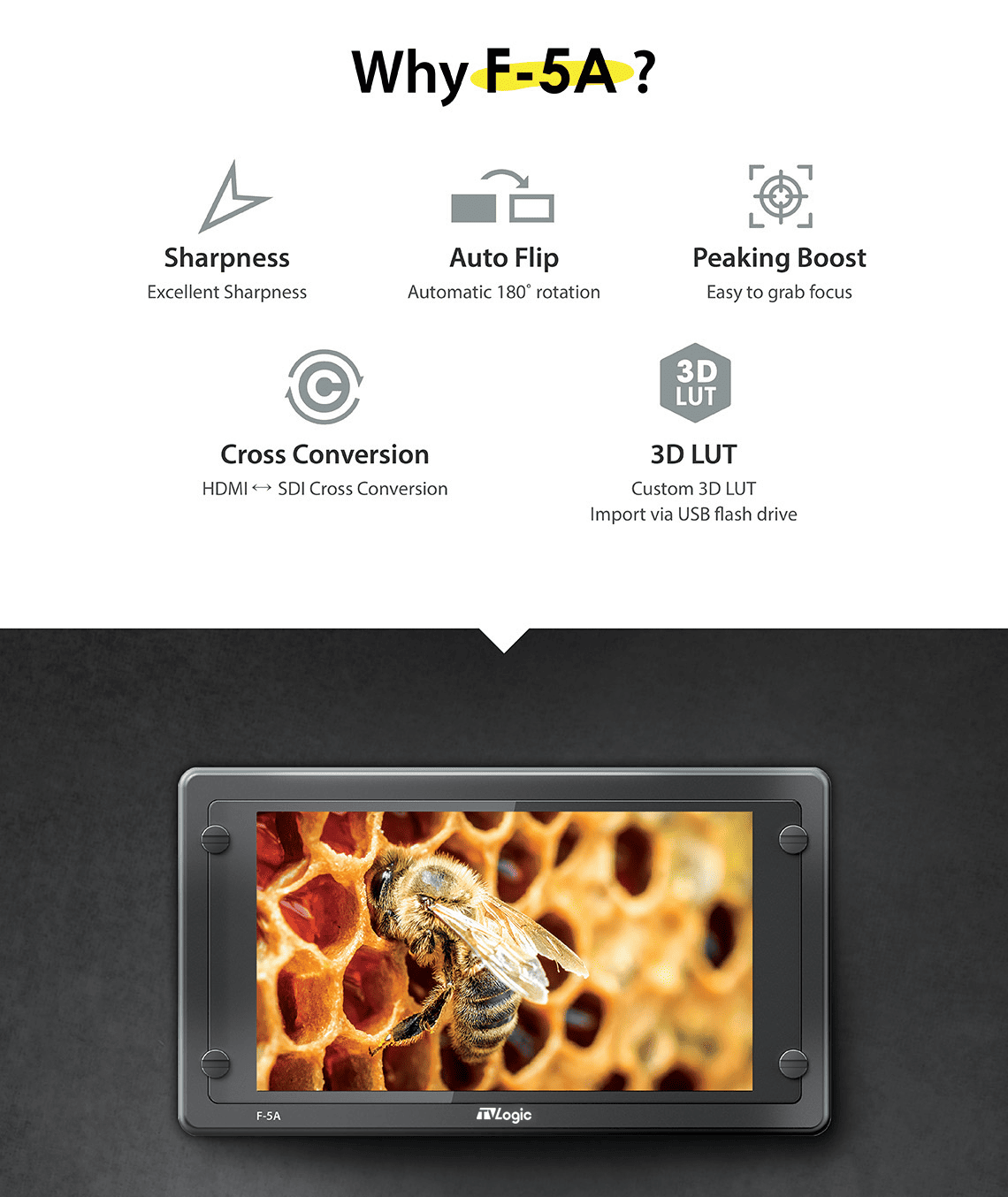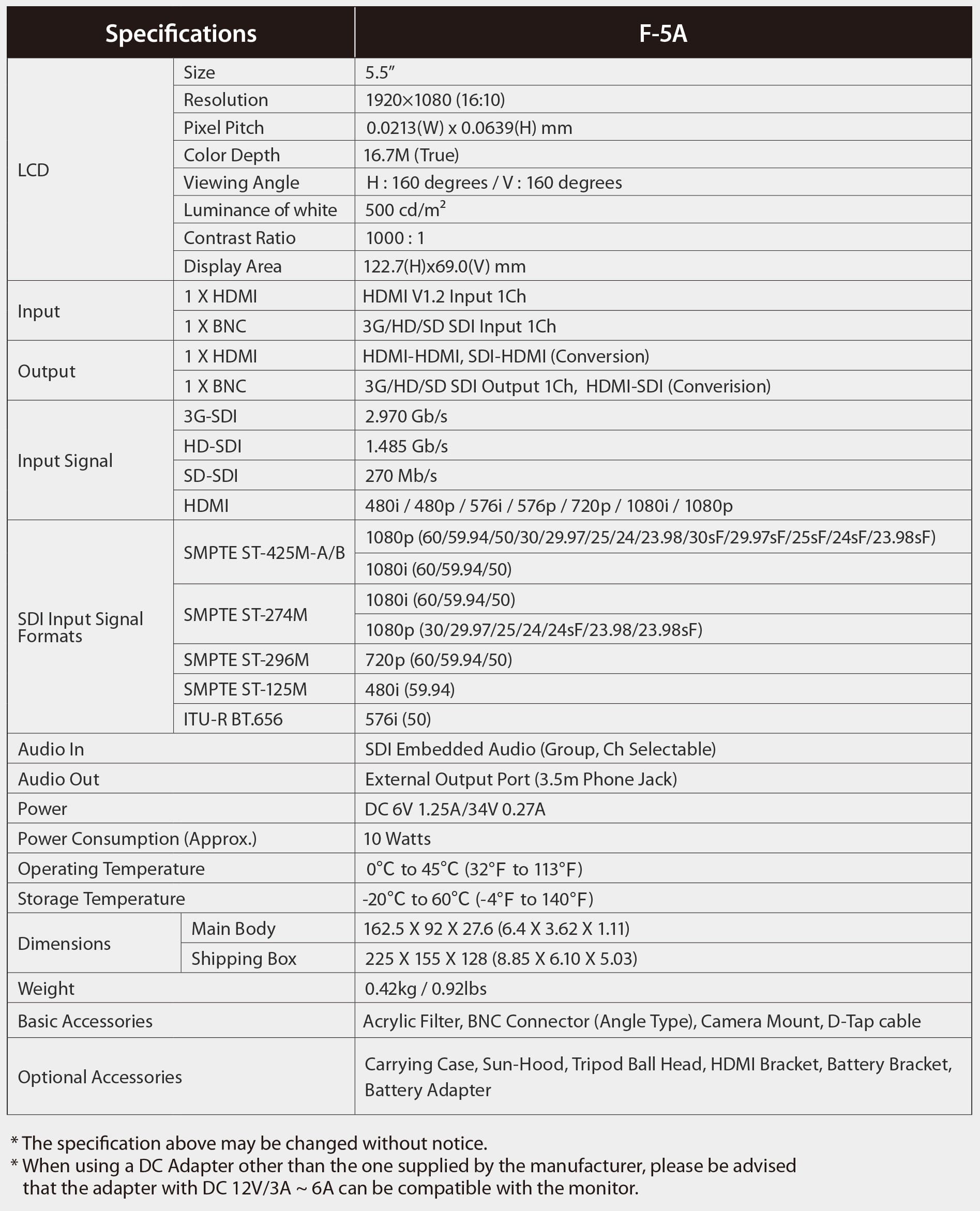F-5A : 5.5’’ Full-featured Field Monitor with FHD IPS-LCD
The F-5A is a compact and light-weight field production monitor with Full HD resolution of 1920 x 1080, nice viewing angle and max luminance of 500nit. Equipped with a new image processing engine, F-5A reproduces even better sharpness and peaking boost capability for focus pullers. It also supports various video formats via 3G-SDI and HDMI 1.3 interface. And also support professional features such as Waveform/Vectorscope, Focus Assist, 3D LUT import, Camera Logs and HDR emulation.
































































5.5” Fully-Featured Field Monitor with
FHD IPS-LCD
The F-5A is a compact and light-weight field production monitor with Full HD resolution of 1920 x 1080, nice viewing angle and max luminance of 500nit. Equipped with a new image processing engine, F-5A reproduces even better sharpness and peaking boost capability for focus pullers. It also supports various video formats via 3G-SDI and HDMI 1.3 interface. And also support professional features such as Waveform/Vectorscope, Focus Assist, 3D LUT import, Camera Logs and HDR emulation.

Main Body Dimensions
Main Body 162.5 x 92 x 27.6 (mm) / 6.39 x 3.6 x 1.11 (inch)
Weight 0.42kg / 0.92 Ibs
Product Highlights
• 5.5” Full HD Resolution (1920×1080)
• HDMI ↔ SDI Cross Conversion
• HDR (PQ, HLG, S-Log3)
• Custom 3D LUT Import
• ARRI Metadata
• Excellent Sharpness
• Peaking Boost
• Waveform / Vectorscope
• H/V Flip
• Auto Flip
• Split Zoom
• Focus Assist
• Anamorphic Desqueeze
• Zoom
• Luma(Y’) Zone Check
• Camera LUTs support
• Built-in battery bracket (Sony L-series)
• Grid
Optional Accessories
HDR Emulation
A true HDR monitor must employ a special display panel with high dynamic range and a wide color gamut, along with being calibrated for PQ and HLG. For example, the LUM-310X (dual layer LCD system) and LUM-310R (LCD with local dimming backlight system) are capable of reproducing a peak luminance of 1,000 nit and 2,000 nit respectively, and a contrast ratio of 1,000,000 : 1; in addition, they cover 99% of the DCI color gamut.


Other monitor utilizing displays with normal luminace range from 0.1nit up to 400nit or high luminance monitor with up to 2000nit with variable black level (0.1 ~ 1.5nit) is defined as 'HDR Emulation monitor' in TVLogic although they have HDR EOTF and related functions. Below is a simple example for your reference.
* True HDR Monitor : HDR Display (~1000nit, 1M CR, DCI gamut) + HDR EOTF & other related function
* HDR Emulation Monitor : Normal Display (~400nit, 1000:1, BT.709 gamut) + HDR EOTF & other related function
And in TVLogic monitors, HDR Emulation function includes the control parameters below;
* Standard Color Mode (HLG, PQ, PQ2)
* Video Range
* Display Luminance *
* HDR EOTF (PQ, HLG) or Camera Logs** (coming soon)
* PQ EETF (On / Off)
* HLG System Gamma (Fixed 1.2 / Auto)
* Color Gamut (BT.709, DCI-P3, BT.2020 and Native mode)
* White Point (D65, D93, DCI)
* Gamut Warning
* Shadow Mode *** (LUM-318G only)
* True HDR Monitor : HDR Display (~1000nit, 1M CR, DCI gamut) + HDR EOTF & other related function
* HDR Emulation Monitor : Normal Display (~400nit, 1000:1, BT.709 gamut) + HDR EOTF & other related function
And in TVLogic monitors, HDR Emulation function includes the control parameters below;
* Standard Color Mode (HLG, PQ, PQ2)
* Video Range
* Display Luminance *
* HDR EOTF (PQ, HLG) or Camera Logs** (coming soon)
* PQ EETF (On / Off)
* HLG System Gamma (Fixed 1.2 / Auto)
* Color Gamut (BT.709, DCI-P3, BT.2020 and Native mode)
* White Point (D65, D93, DCI)
* Gamut Warning
* Shadow Mode *** (LUM-318G only)
1:1 Pixel Mapping Modes for SD/HD
Displays the original image resolution without scaling to match a certain resolution or an aspect ratio.
Anamorphic Desqueeze
Supports several formats and resolutions that are ideally suited for anamorphic lenses and aspect ratios. When shooting anamorphic the image you are monitoring is an “unsqueezed” preview of what’s actually being recorded.



ARRI Alexa Camera Metadata over SDI
Takes the Metadata from the ARRI ALEXA is transported through the SDI outputs of the camera, and displays it on the monitor.


Audio Level Meter Display
Displays the level of the embedded sound signal together with the video signal input through the terminal such as SDI or HDMI.

Blue Only / Mono
Red and Green channels are not used and only Blue or Monochrome channel is used to display the screen. This function is used to adjust the color tones (tones and saturation) of the screen using the SMPTE Color Bar. For example, after displaying the Blue channel, adjust the Color (or Saturation) and Tint (or Hue) so that the original Magenta and Cyan are of the same brightness, and the original Gray and Blue are of the same brightness.

Camera Lut.
Applies the LUTs to the outbound Log signal. A LUT for every major camera manufacturer has been included(LOG-C, C-LOG, S-LOG 1,2,3 and RED Gamma 3,4).


Custom 3D LUT Import
Allows you to load your making 3D-LUT files at NLE software like Davinci Resolve by USB flash memory and displays your LUT on VFM-055A or F-7H. Once you synchronize LUTs in the monitor, you will easily change them on production.

Focus Assist
Assigns a color to the pixels on the boundaries of the image to inform the user to achieve the best focus. With this function, user can easily differentiate the focused area from out-focused area especially when shooting with a shallow depth of field.


H/V Delay
Allows you to check the Blanking area and synchronize signals by displaying the horizontal and vertical intervals in the center of the screen.

H/V Flip
Allows the displayed image to be flipped horizontally or vertically. This feature provides flexible mounting options for camera operators.



Key Lock
Key Lock is a password-protection function of the OSD menu so that non-authorized users cannot change the setting of the monitor.

Luma(Y') Zone Check
Displays the Luma(Y’) level of the input image in colors. Each pixel’s Y’ analyzed and changed to a certain color or zebra pattern according to the Index on the right side of the screen.



Marker
Displays various kinds of aspect ratios on the screen. Wide range of markers and security areas are available with line color and curtain transparency selection. A User Marker is available if any of standard markers fits your requirements.

Max Brightness On/Off
Displays the brightness increases from the normal up to max brightness to obtain a sharp and bright image when shooting outdoors.


Range Error
Analyzes the input signal’s Luma (Y’) and chroma (C’) information. If the input signal exceeds the designated minimum and maximum values, the pixel will blink. This function allows for the user to easily identify any issues with exposure.


Sleep Mode
Sets the LUMINANCE to the minimum value when the time set in the still image output is exceeded.
Split Zoom
Zooms the specified area sequentially.


Time Code Display
Displays the Timecode information on the screen.

User Aspect
Adjusts the Width /Height display ratio.



Various Scan Modes
Controls the size of the image. Overscan: Extra area around the four edges of the image that may not be seen reliably by the viewer. Underscan: Constrains the size of the image so the monitor shows everything the camera is seeing. 1:1 pixel: Displays the original image resolution without scaling to match a certain resolution or an aspect ratio.



Waveform/Vector Scope
Waveform Y: Displays the Luma(Y’), Cb, Cr component of the input signal into waveform.
Vector Scope: Displays the color components ‘B-Y’ and ‘R-Y’of the input signals onto the X-Y axis.
Vector Scope: Displays the color components ‘B-Y’ and ‘R-Y’of the input signals onto the X-Y axis.


Zoom
Magnifies the input signal from 0% to 90%.


Basic Accessory



Optional Accessory














[Release Notes]
Date: 19.07.09
[F-7H [CPU Firmware Update : V11 -> V12]
1. Debugged BackLight values in EcoSaving Mode with high frequency noise
Date: 19.07.04
[F-7H [CPU Firmware Update : V09 -> V11]
1. Improved the calibration / 3DLUT func
2. Improved ArriCam MetaData signal failure error
3. Debugged the issue of changing the signal at Maxbrightness status











